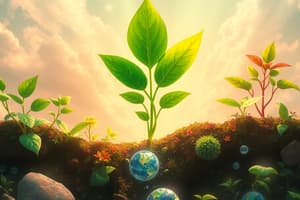Podcast
Questions and Answers
Which factor has the potential to limit photosynthesis by causing stomatal closure?
Which factor has the potential to limit photosynthesis by causing stomatal closure?
- Water Availability (correct)
- Light Intensity
- Temperature
- Nutrient Availability
Increased light intensity always leads to increased photosynthesis.
Increased light intensity always leads to increased photosynthesis.
False (B)
What is the primary function of chlorophyll in photosynthesis?
What is the primary function of chlorophyll in photosynthesis?
To capture light energy.
The byproduct of water splitting during photosynthesis is _____
The byproduct of water splitting during photosynthesis is _____
Match the following factors with their effects on photosynthesis:
Match the following factors with their effects on photosynthesis:
Which of the following is NOT a primary input in the light-dependent reactions of photosynthesis?
Which of the following is NOT a primary input in the light-dependent reactions of photosynthesis?
Higher carbon dioxide concentrations always enhance photosynthesis.
Higher carbon dioxide concentrations always enhance photosynthesis.
Where do the light-dependent reactions take place within the plant?
Where do the light-dependent reactions take place within the plant?
The energy released during electron transport in light-dependent reactions is used to pump _____ into the thylakoid lumen.
The energy released during electron transport in light-dependent reactions is used to pump _____ into the thylakoid lumen.
Which of the following is a product of the light-dependent reactions?
Which of the following is a product of the light-dependent reactions?
Flashcards are hidden until you start studying
Study Notes
Photosynthesis
Factors Affecting Photosynthesis
-
Light Intensity
- Increased light intensity boosts the rate of photosynthesis up to a certain point.
- Beyond saturation point, additional light does not increase the rate.
-
Carbon Dioxide Concentration
- Higher CO2 levels enhance photosynthesis until other factors become limiting.
- Optimal concentration varies by plant species.
-
Temperature
- Photosynthesis typically peaks at an optimal temperature range.
- Extreme temperatures can denature enzymes involved in the process.
-
Water Availability
- Essential for photosynthesis; lack of water can lead to stomatal closure, reducing CO2 intake.
- Excess water can cause root problems, affecting overall plant health.
-
Nutrient Availability
- Nutrients like nitrogen, phosphorus, and potassium are critical for chlorophyll production and overall plant growth.
- Deficiencies can limit photosynthetic capacity.
-
Chlorophyll Concentration
- Higher chlorophyll content increases the plant's ability to capture light energy.
- Factors such as age and health of the plant affect chlorophyll levels.
Light-dependent Reactions
-
Location
- Occur in the thylakoid membranes of chloroplasts.
-
Primary Inputs
- Light energy (sunlight)
- Water (H2O)
- NADP+ (electron carrier)
-
Process Overview
- Light energy is absorbed by chlorophyll, exciting electrons.
- Water molecules are split (photolysis), releasing oxygen (O2) as a byproduct.
-
Electron Transport Chain
- Excited electrons are transferred through a series of proteins in the thylakoid membrane.
- Energy released during the transfer is used to pump protons (H+) into the thylakoid lumen, creating a gradient.
-
ATP and NADPH Production
- Protons flow back into the stroma through ATP synthase, generating ATP.
- Electrons reduce NADP+ to NADPH, both of which are used in the Calvin cycle.
-
Byproducts
- Oxygen is released into the atmosphere as a byproduct of water splitting.
-
Importance
- Provide energy (ATP) and reducing power (NADPH) for the Calvin cycle, essential for synthesizing glucose.
Factors Affecting Photosynthesis
- Light intensity sharply influences photosynthesis rates, enhancing them until a saturation point is reached beyond which no further increase occurs.
- Elevated carbon dioxide concentrations promote photosynthesis, with optimal levels depending on specific plant species.
- Photosynthesis is temperature-sensitive, usually peaking at a specific range; extreme temperatures can damage enzymes and disrupt the process.
- Water is vital for photosynthesis; inadequate water leads to stomatal closure, reducing CO2 uptake, while excess water can harm root systems.
- Essential nutrients like nitrogen, phosphorus, and potassium are crucial for chlorophyll production; deficiencies in these nutrients limit the plant's photosynthetic ability.
- Higher concentrations of chlorophyll enhance a plant's capacity to absorb light energy, influenced by the plant's age and health status.
Light-dependent Reactions
- These reactions occur in the thylakoid membranes of chloroplasts, where critical energy capture occurs.
- Primary inputs include sunlight for energy, water (H2O), and NADP+, which serves as an electron carrier.
- Chlorophyll absorbs sunlight, exciting electrons and initiating the splitting of water molecules (photolysis), releasing oxygen (O2) as a byproduct.
- Excited electrons are transferred through a protein series in the thylakoid membrane, where their energy is utilized to pump protons (H+) into the thylakoid lumen, creating a proton gradient.
- The returning flow of protons through ATP synthase produces ATP, while the reduction of NADP+ to NADPH takes place, with both molecules essential for the forthcoming Calvin cycle.
- Oxygen, generated from the splitting of water, is released into the atmosphere as a byproduct, contributing to environmental oxygen levels.
- The energy (ATP) and reducing power (NADPH) produced during these reactions are crucial for the Calvin cycle, facilitating glucose synthesis.
Studying That Suits You
Use AI to generate personalized quizzes and flashcards to suit your learning preferences.




